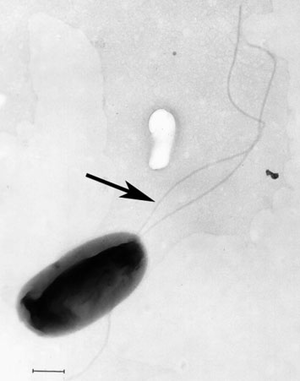Geoalkalibacter subterraneus
Classification
Higher order taxa
Bacteria; Proteobacteria; Deltaproteobacteria; Desulfuromonadales; Geobacteraceae
Species
Geoalkalibacter subterraneus
Description and Significance
Geoalkalibacter subterraneus is a gram-negative motile rod with polar flagella. G. subterraneus does not form spores. cells range in length 1.0-5.0µm, and diameter .5-.6µm.
Genome Structure
Geoalkalibacter subterraneus has one circular chromosome and one plasmid, both have been completely sequenced for strain Red1T[1] The chromosome contains 3.48Mb, 3287 genes and 3202 coding genes with 57.0%GC. The plasmid contains 242Kb, 258 genes and 256 coding genes with 51.4% GC.
Cell Structure, Metabolism and Life Cycle
G. subterraneus is strictly anaerobic. It obtains energy by reducing a variety of oxidized species including Fe(III), Mn(IV), nitrate, elemental sulfur and trimethylamine N-oxide; in the presence of a wide range of electron donors including; acetate, butyrate, isobutyrate, citrate, decanoate, dodecanoate, ethanol, formate, fumarate, glycerol, hydrogenlactate, malonate, methanol, octanoate, palmitate, p-anisate, peptone, propionate, pyruvate, salicylate, stearate, succinate, valerate, isovalerate and yeast extract. G. subterraneus grows optimally at 40°C, pH 7 and salinity 20g/L. G. subterraneus can grow between temperatures 30-50°C, salinity between 1-100g/L, and pH 6-9.
Ecology
Representative strain Red1T was isolated from Redwash oilfield Utah, USA at a depth of 1540 m at 52 °C. The salinity level was measured to be 25 g/L with pH of 7.9. Unlike close relatives, G. subterraneus has a maximum growth rate close to pH 7, which is unusual for the Geoalkalibacter genus which are mostly alkaliphilic. It is unknown whether or not G. subterraneus is indigenous to oil reservoirs. It is likely that the strain was introduced to Redwash oilfield through the water flooding process[2] during secondary recovery, as the closest relatives to G. subterraneus are endemic to rivers, and Redwash oilfield was specifically flooded with river water.
References
Author
Page authored by Luke Pryke and Hannah Pak, students of Prof. Jay Lennon at Indiana University.

